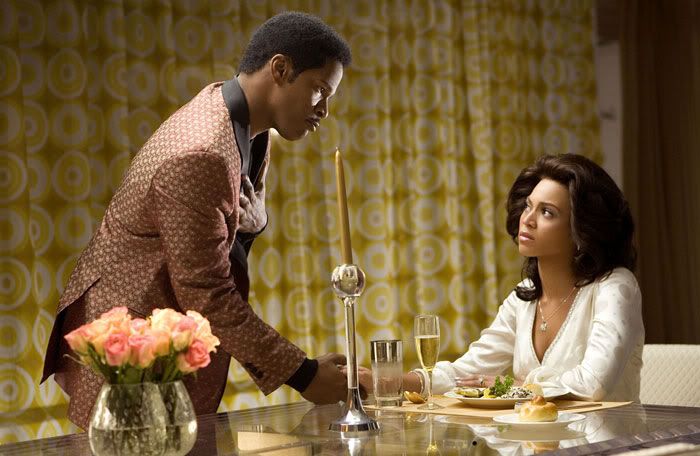On the surface, 2006’s Dreamgirls seems less Baroque than other
contemporary musicals, including Moulin
Rouge and Hedwig and the Angry Inch.
Although it contains a fairly straightforward narrative, it uses the postmodern
technique of hybridization to both mix the musical with the gangster film as
well as blending the types of musicals themselves.
The film’s narrative closely
parallels the gangster film. It is a story about starting at the bottom and
rising through the ranks. Instead of the crime underworld, however, this is
about making it big in the music industry. Jamie Foxx’s character, Curtis,
serves as a stand-in for the types of characters James Cagney and Edward G.
Robinson were known for in the 1930’s. He is starts with nothing but his
ambition and his ideology of breaking through the glass ceiling of the lily
white pop charts. He faces an industry that uses shady tactics such as payola
and flat out stealing material from the black music scene. He responds by
beating them at their own game, also paying to have his music played on the
radio.
 As he begins to rise through the
ranks, he usurps Danny Glover’s role as manager to Eddie Murphy’s musician.
This is very similar to a gangster having his immediate supervisor killed to
help climb the ladder quicker. His rise to prominence is shown through a series
of montages, much like in the gangster films of the past. This even includes
the clichéd spinning newspaper, this time touting the success of his “Dreams”
instead of a crime wave. The backdrop of the civil rights movement even gives
the characters to fear being on the streets, much like the threat of drive-by
shootings always loom on the gangster mind.
As he begins to rise through the
ranks, he usurps Danny Glover’s role as manager to Eddie Murphy’s musician.
This is very similar to a gangster having his immediate supervisor killed to
help climb the ladder quicker. His rise to prominence is shown through a series
of montages, much like in the gangster films of the past. This even includes
the clichéd spinning newspaper, this time touting the success of his “Dreams”
instead of a crime wave. The backdrop of the civil rights movement even gives
the characters to fear being on the streets, much like the threat of drive-by
shootings always loom on the gangster mind.
Upon reaching the top, Curtis must
do whatever it takes to stay there, including stealing Effie’s own music in
much the same way his music had been stolen for American Bandstand. He takes
illegal loans from Mafia backers, adding to the crime film allusions. Taking
these measures to maintain his position turns corrupts him in much the same way
a 1930’s gangster eventually goes from being an anti-hero to a straight
antagonist. Once on top, there is nowhere to go but down, and Curtis faces the
same downfall as the Scarfaces’ and Little Casesars’ of the gangster film as he
is “ratted out” by Beyonce’s character. This breach of loyalty is another motif
heavily borrowed from the gangster film.
In addition to bringing elements of
the crime genre into the musical, it also blends musical tropes. The film
manages to be a backstage musical, cue for song, and integrated musical all at
once. Its subjects are in showbiz and the story focuses on the behind the
scenes of their rise to fame. It also has cue for song moments, such as Eddie
Murphy’s character teaching the girls his music, which transitions into a
musical number. In addition to the songs just being the character’s performing,
they also serve as integrated sequences. The characters go in and out of song
during fights, discussions, and celebrations that are not part of the Dream’s
act. The most interesting use of the cue for song in the film is its use of one
song to cue another, such as Effie’s “And I’m telling you…” which is cued by
the previous song.
By blending the “rags to riches”
narrative of the gangster film into the musical and adding elements of all
types of musicals, Dreamgirls manages
to both feel fresh as well as having a familiarity that genre films thrive
on. The tried and true narrative keeps
the differing approaches to musical numbers from being distracting in a way it
might have otherwise.
No comments:
Post a Comment